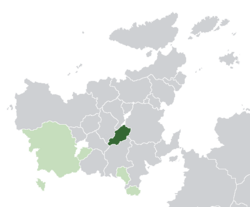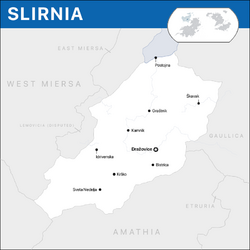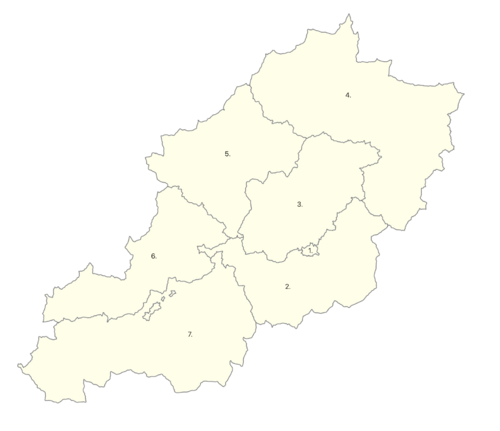Slirnia
Republic of Slirina Republika Slirnija (Slirnian) | |
|---|---|
Motto: "Istina Pobjeđuje" "Truth Prevails" | |
 | |
 Location of Slirnia | |
| Capital and largest city | |
| Official languages | Slirnian |
| Recognised regional languages | Minilovan, Miersan, Gaullican, Amathian and Lemovician |
| Religion | See Religion in Slirnia |
| Demonym(s) | Slirnian |
| Government | Unitary parliamentary constitutional republic |
| Marija Žalac Jovan Tasić Milenko Novaković | |
• Premier | Irena Mesić |
| Suzana Cvetković | |
| Legislature | Parliament |
| Establishment | |
• Duchy | c. 870 |
• Union | 1462 |
• Kingdom | 1780 |
| 1927 | |
| 12 February 1935 | |
| 3 November 1936 | |
• Current Constitution | 1 January 1980 |
| Area | |
• | 136,730 km2 (52,790 sq mi) |
| Population | |
• 2021 estimate | 5,723,452 |
• 2015 census | 5,511,345 |
• Density | 41.86/km2 (108.4/sq mi) |
| GDP (PPP) | 2021 estimate |
• Total | $104,533 million |
• Per capita | $18,264 |
| GDP (nominal) | 2021 estimate |
• Total | $72,988 million |
• Per capita | $12,752 |
| Gini (2020) | 23.1 low |
| HDI (2020) | very high |
| Currency | Slirnian Tolar [a] (STO) |
| Date format | yyyy/mm/dd |
| Driving side | right |
| Calling code | +578 |
| Internet TLD | .sl |
| |
Slirnia (Slirnian: Slirnija), officially the Republic of Slirnia (Slirnian: Republika Slirnija), is a landlocked mountainous country located in the continent of Euclea. It is bordered clockwise, by East Miersa, Gaullica, Amathia, Minilov, Lemovicia and West Miersa; its only coast is reduced to a lakeshore on its north. The territory of Slirnia covers 136,730 kilometres square which distribute between snowed peaks and fertile plains, where the majority of its 5,723,452 inhabitants live.
Prior to the formation of the first Slirnian state, the territory was divided in numerous duchies and principalities, which lived during most of their time under the thrones of other foreign crowns. It was, however, Tomislav Golubović, who unified most of these reigning houses under the Duchy of Dražovice circa 870, marking the first historical trace for the identity of th nation. The Duchy prevailed during the decades cored in the castle of Dražovice until in 1462, the Domnitor Manuel III inherited the territories forming the Unio Trium Nationum, uniting the crowns of Amathia, Dražovice and Carinthia. The personal union between the three crowns, however, was only going to consolidate after a series of conflicts and battles, which concluded during the Great Rebellion of Tirideva that provided Miruvian and Slirnian nobles with a similar position in the structure of the Union as the Amathian ones. The Union would dissolve in 1780, separating the three crowns and establishing the Kingdom of Slirnia under the Belojević House, a state that survived different reigning houses and invasions until the Functionalist occupation of Slirnia during the start of the Great War in 1927. The occupation would remain during most of the course of the international conflict, counting with advances of the Amurgist Amathia on the south.
The end of the Great War saw the return of Slirnian power to the territory and the retirement of Entente forces. The creation of a Slirnian state was proclaimed with the Treaty of _ in 1936, which consolidated the Principality of Slirnia and the inaugural of Prince Tomislav I on the throne. However, a difficult economic panorama and a lack of national unity made the Principality fell in important conflicts. The appearance of councillist revolutionaries created the right moment for the overthrown of the throne and by December of 1935, the country was already immersed in a civil war that would later be known as the Revolution of 1936, year in which it coursed most of its events. Partisans sieged the capital Dražovice and in November 3, they entered in the Princely Palace of Slirnia, achieving the objective of overthrowing the crown an establishing a socialist republic, known between 1936 and 1980 as the Socialist Republic of Slirnia. The new socialist state followed the councils model of Kirenia and the Amathian Council Republic. The SRS remained during its first 24 years under the governments of the Slirnian Socialist Labour Party, until in 1960, the party was absorbed by the Slirnian Section of the Worker's Internationale, with which the nation shifted towards an authoritarian model of governance heavily marked by strict restrictions on the press, personal and collective freedoms and an alignment with the Amathian Equalist Republic. Having achieved a considerable economic development on the previous years, the nation gradually fell into isolation with the government of Slobodan Bijedić, the longest in the political history of the nation. During the decade of the '70s, civil unrest and state repression became more notorious and the incident of the Arsenije Karanović Nuclear Plant forced Ratko Vukašinović to resign. Followed by Pavle Vukomanović, the SRS started a period of important economic difficulties and social discomfort with the regime; the ineffiency of new measures and a students and later workers' movement made the government fell and in 1979, Vukašinović left the office in favour of Petrija Kuzmanović from the Socialist Democratic Party, who led the liberalisation of the nation.
Slirnia is a unitary parliamentary constitutional republic with a social market high-income economy that continues showing signs of the socialist era. The nation outstands in South Euclea for ranking high in women participation, civil liberties, press freedom, democratic governance, housing and overall quality of life. Slirnia is a member of the Euclean Common Defense Treaty Organization, the Community of Nations, the Global Institute for Fiscal Affairs, the International Trade Organization and is a founding member of the Association of South Euclean States. As of 2020, it is an officially recognised candidate for a membership of the Euclean Community.
History
Early settlements
Duchy of Dražovice (1400–1780)
Kingdom of Slirnia
Great War and occupation (1927-1935)
Principality of Slirnia (1935-1936)
Slirnian Revolution of 1936
Socialist Republic of Slirnia (1936-1980)
Republic of Slirnia (1980-present)
Geography
Climate
Politics
Foreign relations
Administrative divisions
|
|



